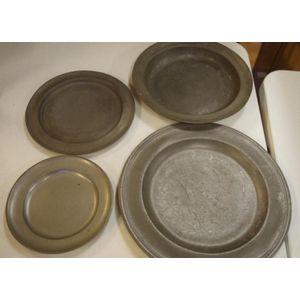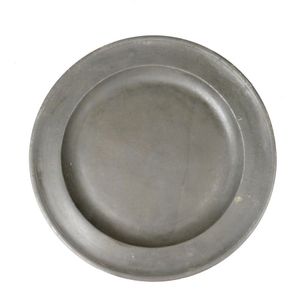Georgian Pewter Serving Dishes, 1820
Three Georgian large pewter circular serving dishes, circa 1820, with various marks verso, 42 cm diameter
You must be a subscriber, and be logged in to view price and dealer details.
Subscribe Now to view actual auction price for this item
When you subscribe, you have the option of setting the currency in which to display prices to $Au, $US, $NZ or Stg.
This item has been sold, and the description, image and price are for reference purposes only.
- Circa - A Latin term meaning 'about', often used in the antique trade to give an approximate date for the piece, usually considered to be five years on either side of the circa year. Thus, circa 1900 means the piece was made about 1900, probably between 1895 and 1905. The expression is sometimes abbreviated to c.1900.
- Georgian - As an English stylistic period, Georgian is usually taken to cover the period from George I (1714) to the Regency of Prince George (1811-20), although the period from 1800 to 1830 is sometimes designated as the Regency period. During the Georgian period the great English cabinetmakers and designers such as Chippendale, Hepplewhite, Adam Sheraton etc., were all active.
Therefore there isn't a single 'Georgian style' as such and to say something is 'Georgian', usually means it was made between 1714 and 1830. This assumes we discount George V and George VI, both being from the 20th century.
The styles popular at the time of each reign were:
George I (1714-1727) saw out the last years of the Baroque period.
George II (1727-1760) reigned during the Rococo period.
George III (1760-1820) saw the last gasp of the Rococo, all of the early Neo-Classic 'Adam style' and most of the later neo-Classic 'Regency style'.
George IV (Prince Regent 1820-1830)encompassed the last of the 'Regency' style.
William IV's reign (1830-1837) was something of a no man's land (stylistically) and he wasn't a 'George' anyway. He covered the last glimmerings of 'Regency' and the start of the 'Victorian' style. - Verso - Verso is the "back" side of a sheet of paper, art work, coin or medal. The front side is "recto".
This item has been included into following indexes:
- plates - pewter 141
Visually similar items

Three antique pewter platters the largest, 42 cm diameter
Sold by
in
for
You can display prices in $Au, $US, $NZ or Stg.

Robert Barron, circular platter with a rust glaze, circa 1994, 41 cm width
Sold by
in
for
You can display prices in $Au, $US, $NZ or Stg.

Four antique pewter chargers including 18th century
Sold by
in
for
You can display prices in $Au, $US, $NZ or Stg.

A large Georgian pewter charger, plain design, touchmarks John Aughton on the base. Diameter 42 cm
Sold by
in
for
You can display prices in $Au, $US, $NZ or Stg.
